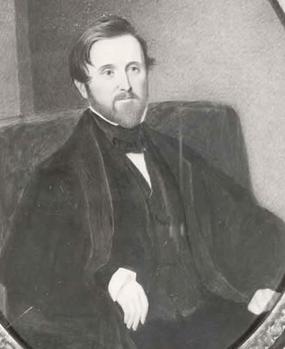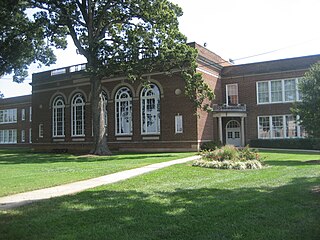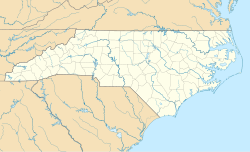
The University of North Carolina at Greensboro is a public research university in Greensboro, North Carolina. It is part of the University of North Carolina system. It is accredited by the Southern Association of Colleges and Schools Commission on Colleges to award baccalaureate, master's, specialist, and doctoral degrees.

North Carolina Agricultural and Technical State University is a public, historically black, land-grant research university in Greensboro, North Carolina, United States. It is a constituent institution of the University of North Carolina System. Founded by the North Carolina General Assembly on March 9, 1891, as the Agricultural and Mechanical College for the Colored Race, it was the second college established under the provisions of the Morrill Act of 1890, as well as the first for people of color in the State of North Carolina. Initially, the college offered instruction in agriculture, English, horticulture and mathematics. In 1967, the college was designated a Regional University by the North Carolina General Assembly and renamed North Carolina Agricultural and Technical State University.

Alexander Jackson Davis was an American architect known particularly for his association with the Gothic Revival style.

Blandwood Mansion is a historic house museum at 447 West Washington Street in Greensboro, North Carolina. Originally built as a four-room Federal style farmhouse in 1795, it was home to two-term North Carolina governor John Motley Morehead (1841-1844) under whose ownership it was transformed into its present appearance. It is believed to be the oldest extant example of the Italian Villa Style of architecture in the United States, and was designated a National Historic Landmark in 1988. In creating the design for Blandwood, architect Alexander Jackson Davis produced a popular prototype for American house designs in the Italianate style: a central tower projecting from the main facade. Saved from demolition in 1964 by preservation-minded Greensboro citizens, the house was opened as a museum in 1976 and remains open to the public today.

The Alice Freeman Palmer Memorial Institute, better known as Palmer Memorial Institute, was a school for upper-class African Americans. It was founded in 1902 by Dr. Charlotte Hawkins Brown at Sedalia, North Carolina near Greensboro. The institute was named after Alice Freeman Palmer, former president of Wellesley College and benefactor of Dr. Brown.

College Hill is a neighborhood in the west central section of the United States city of Greensboro, North Carolina. College Hill was Greensboro's first neighborhood.
William Augustus Edwards, also known as William A. Edwards was an Atlanta-based American architect renowned for the educational buildings, courthouses and other public and private buildings that he designed in Florida, Georgia and his native South Carolina. More than 25 of his works have been listed on the National Register of Historic Places.

Starrett & van Vleck was an American architectural firm based in New York City which specialized in the design of department stores, primarily in the early 20th century. It was active from 1908 until at least the late 1950s.

James Benson Dudley High School is a four-year public high school located in Guilford County in the city of Greensboro, North Carolina. Dudley High School was founded in 1929 as the first black high school in Guilford County, in a school system segregated by law. The school was named for James Benson Dudley.

William Lee Stoddart (1868–1940) was an architect who designed urban hotels in the Eastern United States. Although he was born in Tenafly, New Jersey, most of his commissions were in the South. He maintained offices in Atlanta and New York City.
Hobart Brown Upjohn (1876–1949) was an American architect, best known for designing a number of ecclesiastical and educational structures in New York and in North Carolina. He also designed a number of significant private homes. His firm produced a total of about 150 projects, a third of which were in North Carolina.

Richard Sharp Smith was an English-born American architect, noted for his association with George W. Vanderbilt's Biltmore Estate and Asheville, North Carolina. Smith worked for some of America's important architectural firms of the late 19th century—Richard Morris Hunt, Bradford Lee Gilbert, and Reid & Reid—before establishing his practice in Asheville. His most significant body of work is in Asheville and Western North Carolina, including dozens of buildings that are listed on the National Register of Historic Places or are contributing structures to National Register Historic Districts.

The former Charles D. McIver School is a historic school building located in Greensboro, Guilford County, North Carolina. It designed by architects Starrett & van Vleck in Classical Revival style. It was built in 1923, and is a long, symmetrical, two-story building faced with dark, wire-cut bricks. It features a central projecting pavilion that contains the school auditorium. The building was last used as an elementary school in the 1970s. It was used as a school for special needs children until the early 2000s. It was named for Charles Duncan McIver (1860–1906), founder and first president of the institution now known as The University of North Carolina at Greensboro.
Orlo Epps was an American architect, mathematician, physicist, and socialist writer.

Charles E. Hartge was an American architect who was born in Hamburg, Germany as Carl Emil Hartge. His work still stands today in North Carolina.
Charles Christian Hook (1870–1938) was an American architect. He was also the founder of FreemanWhite, Inc. a Haskell Company (1892), the oldest practicing firm in North Carolina and currently the 11th oldest architecture firm in the United States.

The Greensboro History Museum, consisting of the former First Presbyterian Church of Greensboro and Smith Memorial Building, is a historic museum building located at 130 Summit Ave. in Greensboro, Guilford County, North Carolina. The former Presbyterian church was built in 1892 on the site of a former Confederate hospital, and is a Romanesque Revival-style brick building with a cross gable roof and tower. The semi-circular, 11 bay, Smith Memorial Building was built in 1903. It features four octagonal sides and a tower. The memorial building was designed by the architect Charles Christian Hook (1870-1938). The church and memorial building were connected and the older structures modified and renovated in 1938. Also located on the property is the First Presbyterian Church cemetery, established in 1831, after the first church was built on land that was donated by Jesse H. Lindsay. The church vacated the property in 1929, and in 1937-1938 it was renovated and enlarged as the Richardson Civic Center and donated to the city of Greensboro. It subsequently housed the Greensboro Public Library, the Greensboro Historical Museum, and the Greensboro Art Center. The historic building functions as one part of the current, larger Greenboro History Museum.

Julius Isaac Foust (1865–1946) was the second president of the school now known as The University of North Carolina at Greensboro, serving from 1906 until his retirement in 1934.

The Agricultural and Technical College of North Carolina Historic District is 10.1-acre (41,000 m2) historic district along the western boundary of the campus of North Carolina Agricultural and Technical State University in Greensboro, North Carolina. The area includes five historical Colonial Revival, Classical Revival style buildings. Some significant structures are among those located within the Historic District include the James B. Dudley Memorial Building and Harrison Auditorium. The district has been listed on the National Register of Historic Places since October 20, 1988.



















